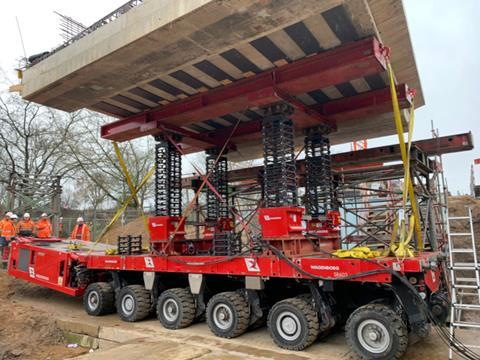Wagenborg Nedlift has used Enerpac JS-250 jack-up and SCJ-100 cube jack systems to lift and install railway and pedestrian bridges at Leverkusen in Germany.

The bridge deck placements occurred over a weekend ahead of the laying of a railway track on the Rhine-Ruhr Express (RRX) line, which is being upgraded to reduce delays caused by long distance, regional and freight transport sharing the same tracks.
At Leverkusen, the bridge on Rathenaustrasse has been widened to accommodate the new railway line on the Langenfeld/Leverkusen section. Wagenborg was tasked with installing two bridges next to the existing bridge: a main track bridge and a pedestrian/cycle bridge.
Pre-assembly of both bridge decks at a height of 4.3 m was undertaken parallel to the rail line. Wagenborg used a combination of Enerpac jack-ups and SPMTs to first move the decks 10-15 m and then lower them onto bridge bearings to complete the installations.
The railway bridge – weighing 483 tonnes and measuring 21 m long and 7.7 m wide – was installed first using the JS-250 jack-up system: four lifting towers resting on four SPMTs. The deck was raised to 7 m, lifting it above the bridge abutments, and lowered into position using the jack- up system.
The 7.5 m-long and 7.1 m-wide pedestrian and cycle bridge, weighing 90 tonnes, was moved into position using four SCJ-100 cube jacks on a single SPMT. As the bridge deck was being raised to 5.5 m, and the cube jacks raised to 2.7 m, bracing was needed to reduce the effect of sideload. The narrow gap was just wide enough fit the SPMT.
According to Wagenborg, using the cube jacks to lower the bridge deck was far quicker than using traditional jack and pack – it took just 10 minutes compared with two hours.
















